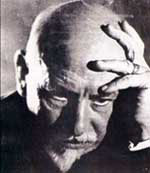Pirandello's Six Characters and Modernist Theater
-
German Expressionism (1905-ca. 1920)
-
Antonin Artaud (1896-1948): Theater of Cruelty
-
-Mise-en-scène
(putting into scene)
-
Bertolt Brecht (1898-1956): Verfremdungseffekt
(alienation effect)
-
Teatro Stabile
movement (1898-1920): theater in Italian that was concerned with moral
and spiritual issues, not about box office demand
-
Sigmund Freud (1856-1939): Psychoanalysis
-
Constantin Stanislavski (1863-1938): Method acting
-
-
related to Dada and
Surrealism
- Expressionism/Modernism
- Setting: angles, light and shadow, distorted “reality”
- WWI aftermath: uncertainty, fascism, mental instability
- Psychoanalysis and the uncanny
- Same question as Pirandello: Is it possible to stage “reality”?
What is “reality”?
I: Luigi
Pirandello

(1867-1936)
- Born in Sicily
- 1887-1991: University in Rome and Bonn
- 1894: Marries Antonietta Portulano
- 1904: first novel
- 1914-17: Sons POW in WWI and wife growing insane
- 1919: Wife in mental institution
- 1921: Six Characters in Search of an Author
- 1923: Henry IV; joined fascist party
- 1934: Opera libretto criticized by fascist authorities; doesn’t
support Mussolini’s march into Ethiopia
[I]n dramatic art, what is staging if not a huge,
living illustration in action? What are the actors
if not illustrators in their own right?
But necessary illustrators in this case, alas. [ . . . ]
Unfortunately, there always has to be a[n]
unavoidable element that intrudes between the
dramatic author and his creation in the material
being of the performance: the actor”
(qtd. in “Illustrators, Actors, Translators,” Luigi Pirandello in
the Theatre: a Documentary Record,
eds. S. Bassnett and J. Lorch, [Philadelphia: Harwood, 1993] 26-7).

Questions:
What’s the plot of the play?
Why do the characters need an author?
Why are there no names assigned to the characters?
Why do the characters think they’re immortal?
Is there a parallel to predestination/Calvinism?
Why do the characters choose the manager to help them?
Why do the characters need an author now?


